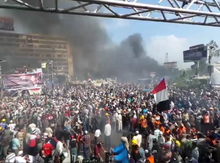| Rabaa massacre | |
|---|---|
| Part of the Post-coup unrest in Egypt (2013–2014) | |
 Rabaa el-Adaweya Square during the dispersal of the pro-Morsi sit-in | |
| Location | Cairo, Egypt |
| Date | August 14, 2013 |
| Target | Pro-Morsi demonstrators:
|
| Deaths | Estimates vary
|
| Injured | At least 3,994 injured[8] |
| Perpetrators | Egyptian Security Forces |
| Motive | Protest dispersal |
On 14 August 2013, the Egyptian police (and to a lesser extent the armed forces), under the command of then-Defense Minister Abdel Fattah el-Sisi, used lethal force to “disperse” two camps of protesters in Cairo: one at al-Nahda Square and a larger one at Rabaa al-Adawiya Square. The two sites had been occupied by supporters of President Mohamed Morsi, who had been removed from office by the military a little over a month earlier following mass protests against his rule. Initiatives to end the six-week sit-ins by peaceful means had failed, and the camps were cleared out within hours.[10]
Human Rights Watch described the sit-in dispersals as crimes against humanity, and called them "one of the world's largest killings of demonstrators in a single day in recent history", in reference to the numerous deaths that occurred.[11]
The exact death toll during the incident is unclear, and multiple sources have given conflicting estimates. HRW states that at least 904 protesters were killed (817 in Rabaa Square and 87 in al-Nahda Square), while strongly suggesting that at least 1,000 protesters died during the dispersal.[12] The Egyptian Health Ministry announced that 595 protesters and 43 police officers were killed, and at least 3,994 individuals were injured.[8][13][14] The official Forensic Medical Authority stated that the number of police officers killed was eight.[15] Egypt's National Council for Human Rights stated that at least 624 civilians were killed.[6] The Muslim Brotherhood and the National Coalition for Supporting Legitimacy stated the number of deaths from the Rabaa al-Adawiya Mosque sit-in alone was about 2,600.[9][16] The total casualty count made 14 August the deadliest day in Egypt since the 2011 Egyptian revolution which toppled former President Hosni Mubarak.[17]
Several world leaders denounced the deadly violence during the sit-in dispersals.[18][19] As the violent acts of retaliation by Islamist groups followed in several cities across Egypt, the military-appointed interim government declared a three-month-long state of emergency and curfews were enforced in many cities.
- ^ "Morsi supporters end brief sit-in outside High Court in Cairo". Al-Ahram. 12 August 2013. Archived from the original on 15 August 2013. Retrieved 24 August 2013.
- ^ "Islamist forces join together for Rabaa Al-Adaweya protest". Daily News Egypt. 28 June 2013. Archived from the original on 4 July 2013. Retrieved 29 June 2013.
- ^ "Egypt at a bleak crossroads". 18 August 2013. Archived from the original on 27 August 2013. Retrieved 24 August 2013.
- ^ "Egypt's Rabaa massacre: one year on". Daily News Egypt. 16 August 2014. Archived from the original on 19 March 2015. Retrieved 6 February 2015.
- ^ "Egypt: Rabaa Killings Likely Crimes against Humanity". Human Rights Watch. 12 August 2014. Archived from the original on 16 August 2014. Retrieved 15 August 2014.
- ^ a b "Arab rights body calls for halt to execution of 12 Muslim Brotherhood members".
- ^ "Egyptian report blames both Islamists, security forces for violence". Los Angeles Times. 17 March 2014.
- ^ a b c Cite error: The named reference
DeathToll-16-8-13was invoked but never defined (see the help page). - ^ a b "Egypt's Brotherhood to hold 'march of anger'". Al Jazeera. 16 August 2013. Archived from the original on 16 August 2013. Retrieved 18 August 2013.
- ^ "Rabaa Al-Adawiyah Mosque Destroyed in Cairo Clashes". HuffPost. 15 August 2013. Archived from the original on 15 August 2013. Retrieved 17 August 2013.
- ^ "Egypt: Rab'a Killings Likely Crimes against Humanity". Human Rights Watch. 12 August 2014. Archived from the original on 16 August 2014. Retrieved 15 August 2014.
- ^ "All According to Plan". Human Rights Watch. 17 August 2013. Archived from the original on 19 July 2015. Retrieved 15 August 2014.
- ^ "Death toll from Egypt violence rises to 638: Health ministry". Al-Ahram. 15 August 2013. Archived from the original on 16 August 2013. Retrieved 19 August 2013.
- ^ Kirkpatrick, David D. (15 August 2013). "Islamists Debate Their Next Move in Tense Cairo". The New York Times. Archived from the original on 17 August 2013. Retrieved 19 August 2013.
- ^ "Reference at www.middleeasteye.net". Middle East Eye.
- ^ "NSF spokesman quits over Rabaa, Nahda massacres". World Bulletin. 14 August 2013. Archived from the original on 2 October 2013. Retrieved 18 August 2013.
- ^ Hauslohner, Abigail; Sharaf al-Hourani (14 August 2013). "Scores dead in Egypt after security forces launch assault on protesters' camp". The Washington Post. Archived from the original on 15 August 2013. Retrieved 14 August 2013.
- ^ "Global condemnation of Egypt crackdown". Al Jazeera. 15 August 2013. Archived from the original on 25 August 2013. Retrieved 7 September 2013.
- ^ "Most world states condemn Egypt's violence". Al-Ahram. 15 August 2013. Archived from the original on 23 August 2013. Retrieved 7 September 2013.